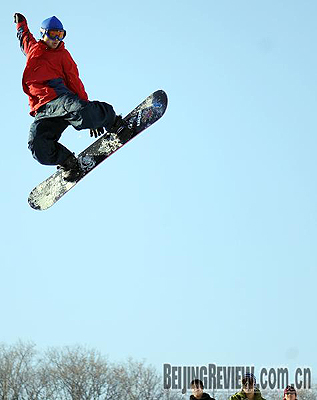|

Driving out to the suburbs of Beijing with friends and spending time at a ski resort is now a common way for Wei Tao to enjoy his winter weekends.
"You can either enjoy the excitement of skiing down the slopes at high speed or appreciate the quiet beauty of the surrounding hills covered with thick snow," said Wei, 40, a manager of the market and development department of a Beijing-based real estate company.
Wei and his wife are ski fanatics and have gradually improved their skill level over the years. "I can now ski at the middle-level ski runs," Wei said proudly.
Like Wei, more and more Chinese have taken up skiing as a recreational activity and winter sport. There was a time when skiing was seen as the exclusive preserve of the wealthy, like golf, but times have changed. With the development of China's economy and changes in lifestyles of Chinese people, this sport is now available to the masses.
An investigation of the Chinese Ski Association (CSA) shows that the number of people who strapped on skis in 2004 increased to 3 million, rising from tens of thousands in 1999. Most of them were not skilled skiers though.
According to www.skiing.org.cn, CSA's official website, the number of ski resorts in China increased by 20 to 30 annually over the past few years, topping 200 last year. But there were only a dozen or so in 1996 and most of them were used for the training of professional skiers.
Today, ski resorts ranging in size are scattered in 15 provinces, autonomous regions and municipalities throughout China, with almost all of them catering to the needs of an ever more appreciative public.
"The increase in the number of ski resorts and skiers proves that skiing is no longer just for professionals or for the rich. It has indeed become a sport that attracts the wide participation of the ordinary Chinese," An Linbin, Deputy Secretary of the CSA, said at the opening ceremony of an international skiing competition held in China in March 2008.
An article on CSA's website said that in the past ski resorts were usually built in the frigid northeast region of China. But now, using snowmaking technology, many places that are warmer than the northeast, such as Inner Mongolia, Hebei, Xinjiang and Beijing, have seen a growing number of ski resorts.
Take Beijing for example. The website said in 1999 it had only one ski resort, but by 2004 the number had increased to 13, with the total length of ski runs exceeding 40,000 meters and the number of skiers topping 50,000 a day.
The demand, it seems, is still rising. According to the Marketing Department of the Nanshan Ski Resort, one of the largest ski slopes in Beijing, the resort had 2,000-3000 skiers enter daily in December 2008.
Even the warm areas in southwest China, like Sichuan and Yunnan provinces, have jumped on the bandwagon, while in Beijing, Shanghai and other big cities, indoor ski clubs are mushrooming, enabling ski lovers to enjoy their sport all year round.
For Chinese ski lovers, the reasons they head for the slopes vary. Some think the activity is part of a fashionable lifestyle, while others are truly attracted by the charm of skiing itself.
With four years of skiing experience under his belt, Wei said he loves the feeling of excitement skiing brings him. "I like skiing down the hill at high speed on a clear day with the blue sky, white snow and fresh air-all of these make me feel good," he said.
While his wife Chen Mei, 36, an editor at a Beijing-based website, said that the most important reason for her to choose skiing is the health factor, as people have few alternatives for exercise in winter.
Mid-December to February is prime skiing time in China, with resort prices being relatively cheaper than in foreign countries. With the increase in competition, many ski resorts in China reduce their prices to attract customers. In some less luxurious resorts, skiers can spend the entire day for as little as 50 yuan ($7).
Apart from dropping prices, many resorts provide other attractions such as hot springs, ice lantern displays and countryside food tasting.
Beginners are well cared for at resorts in Beijing, Tianjin, Hebei or Inner Mongolia where professional instructors are on hand to coach novices.
Those who are more experienced can head for the resorts in the northeast, like Yabuli Ski Resort in Heilongjiang, the northernmost province in China. The ski resort boasts the largest and the best slopes in the country. Besides satisfying the needs of ordinary ski lovers, it is also the base for the national skiing team of China.
Besides, Chinese now also have opportunities to ski overseas. Many travel services have designed ski tours to attract tourists. Gao Fulai, who heads up the Japan market of the Beijing Youth Travel Service, told Beijing Review that in 2008 the company specially organized skiing tours to Japan's Hokkaido.
| 